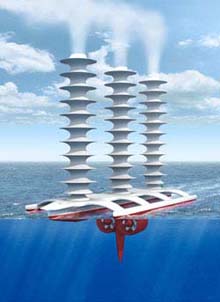Proposals to manipulate Earth’s climate to reduce greenhouse warming are getting traction as our mitigation efforts fail to make headway. They promise quick results, but their potential deployment opens an enormous can of worms. [25 May 2010 | Peter Boyer]
“Global warming and sustainability are the great challenges of our time, but we can’t afford to wait for government policy. Billionaires can and will save the world.” So said renewable energy billionaire Harrison Wyld in an interview late last month.
Wyld is putting his money where his mouth is, investing a sizeable chunk of his fortune in a venture that seeks to pump sunlight-reflecting sulphur particles into the upper atmosphere, cooling the planet while also causing the sky to turn pale blue.
The Wyld project’s name, “Bluebird”, disguises some big issues that are troubling more than a few observers. A physicist who has resigned from the project, Dr Kyle Vandercamp, and a brilliant young artist and mathematician, Lulu Richmond (“lulurich” to her Twitter friends), have come together in a “Stop Bluebird” campaign.
Things are hotting up. There’s evidence that the Bluebird plans are already being put into effect, and the other day Dr Vandercamp’s car (fortunately without him inside) suddenly burst into flames, an event he found “intimidating”.
You’ve probably decided by now that this has to be fiction, and you’d be right. Well, almost. The characters are part of the ABC “alternative reality” internet drama, Bluebird, now into its fifth week. But billionaires getting into climate “solutions” and notions of shooting stuff into the atmosphere to cool the planet are all too real.
When yet another record profit, company acquisition or Fortune 500 listing no longer turns them on, some very rich people turn to philanthropy, putting spare cash into helping others. Whatever their motives, the money is invariably welcomed by its hard-working, cash-strapped recipients, and their gestures usually get a good press.
Ted Turner (CNN), Richard Branson (Virgin) and Bill Gates (Microsoft) won their wealth in different ways, but one thing they presently share is an interest in a healthy environment. Turner has given money to the UN, and Branson has put money into making aviation more carbon-friendly.
The Gates Foundation exists mainly to improve the health of the world’s poor, but the environment has always been a subtext of Bill Gates’s philanthropy. Now he’s putting cash into a project involving — wait for it — hundreds of ships sucking up a million tonnes of seawater every day and spraying it into the atmosphere to whiten clouds, thereby reflecting sunlight back into space.
We can’t yet determine the merits of the estimated $US 6 billion “Silver Lining” project — one thing to remember is that water vapour is a greenhouse gas — and the Gates Foundation is at this stage giving only $US300,000 for research, but it’s significant that this highly-organised and well-resourced foundation is prepared to get involved.
It was bound to happen. As the physical evidence mounts for a steadily warming planet threatening life systems (including our own), and as the battle to contain emissions seems every day less winnable, we start to look to emergency measures, the things we do when all else is failing.
The geoengineering option appeals especially to people with a technological bent, and there are numbers of those among green entrepreneurs, including such digital wizards as Vinod Khosla (Sun Microsystems), John Doerr (Kleiner Perkins), and Google co-founders Larry Page and Sergey Brin.
If such movers and shakers haven’t yet turned to geoengineering, they will be tempted. Where energy conservation and carbon mitigation schemes seem painfully slow to get results, many proposed geoengineering projects are projected to have an impact within a year or two.
But nothing’s that simple. Such measures invariably carry greater risk than steady, long-term remedies. The level of risk attached to global-scale geoengineering is unprecedented, with potential adverse side-effects for the whole planet, perhaps for a very long time.
The consequences of any action involving changes to our atmosphere may include something unintended that we don’t yet know about, just as a few decades ago we had little idea of the impact of chlorine-based chemicals on the ozone layer, or of industrial sulphur emissions on the acidity of rainwater — or of carbon emissions on the temperature of the planet.
It is almost certain that the initial cost of developing and implementing geoengineering measures is only a starting point, and that the real cost — quite possibly so big that it’s impossible to measure — will come with those other, presently unknown, consequences.
The very act of rolling out geoengineering projects, if not adequately dealt with in international negotiations, may spark conflict between countries. In the longer term, geoengineering projects will be open to attack from people faced with adverse weather events like drought and crop failures. Playing God with the atmosphere is a giant can of worms, if ever there was one.
We can’t eliminate geoengineering from our climate toolbox. We know that if our emissions remain stubbornly high as we get closer to tipping points, like ice-sheet disintegration or massive Arctic methane release, we’re more likely to favour desperate measures to save what we have left.
But geoengineering will always carry with it the stigma of defeat — a last resort because we couldn’t curb our excesses. Economists have already done the sums on mitigation and proven that it’s manageable. We need to get that under way before desperation kicks in.

